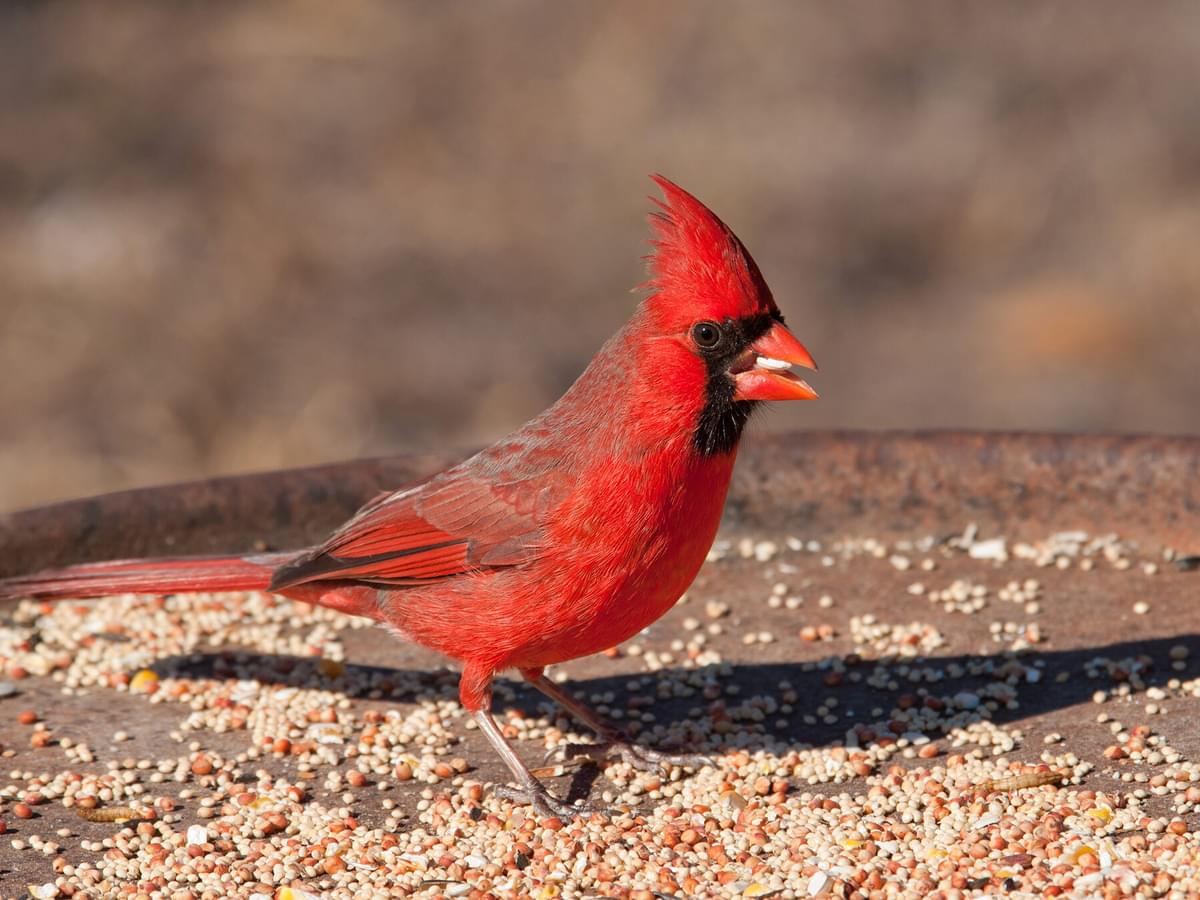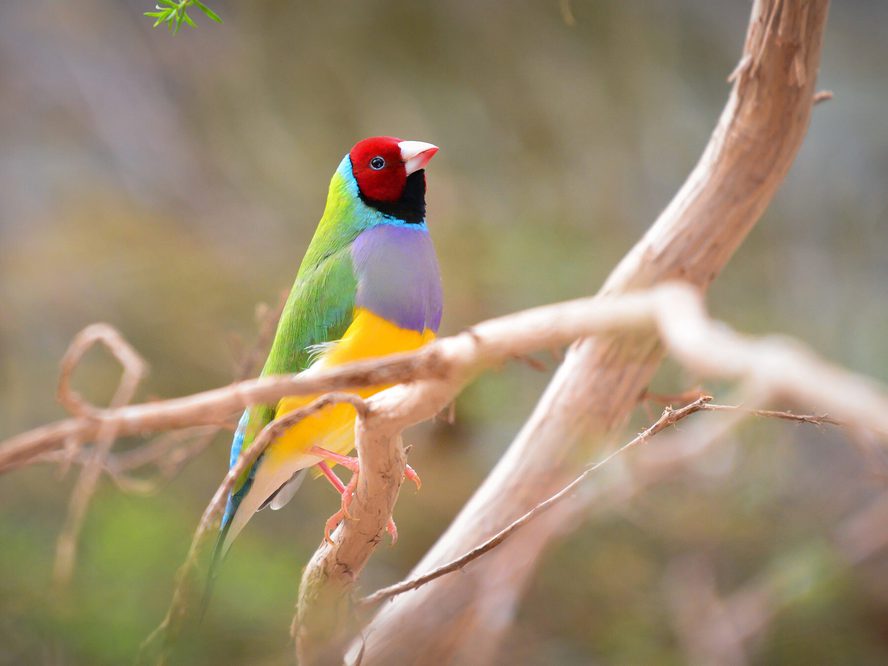Jump to Section
How Do Birds Find Bird Feeders? (And Where To Put Them)
Last updated: 17 June 2022

Modern bird feeders don’t look much like anything birds find out in nature. So how do birds find them? The bird feeder itself probably has little attraction value, but the food it contains certainly does! Bird seed might not look very eye-catching to us, but birds are keyed into the food sources they rely on.
Birds are able to learn what different food sources look like, and by association, they may be able to learn that bird feeders mean a free meal. They will check feeders regularly as part of their daily foraging to see when they have been filled up. Birds are also very aware of their surroundings, so observing and listening to other birds in the area will also alert them to the presence of a feeder or other food source.
Birds have excellent vision, and they are able to detect more colors than we can. They need to feed regularly, and they will spend much of their day in search of food. It can take some time for birds to find and begin visiting new bird feeders, especially if they are not accustomed to being fed. With some patience and by placing feeders in appropriate locations, it is usually only a matter of time before the first birds begin to visit.
Continue reading to learn more about how birds find bird feeders.

Black-capped Chickadee at a feeder
Where is the best place to put a bird feeder?
There are many factors to consider when deciding where to place your bird feeder. Firstly, you probably want to be able to observe the birds, so the ideal position is in line of sight with a window. Collisions with windows happen often as birds fly away from feeders. Do not place your feeder directly in front of a window but rather at an angle so that collisions will be less severe.
Bird safety goes further than just preventing window collisions. You’ll also want to minimize the chance of neighborhood cats or other predators like sharp-shinned and coopers hawks feeding on the visiting songbirds.
Place your bird feeder on a pole or hang it up at least 5 or 6 feet above the ground to keep the birds safe from cats. Positioning the feeder a few feet away from some bushes or a dense tree will also provide the birds an escape route from hungry hawks. You may need to go up to 12 feet away from the nearest tree if you have squirrels around, however.

Ensure you put your bird feeders at least 5 to 6 feet above the ground to ensure safety for the birds
Birds will feed most comfortably in a quiet area that does not receive a lot of foot or road traffic. If you have dogs, they could also frighten the birds, so keep that in mind too. You can place your bird feeders in the shade if you live in a very hot area, or in the sunshine in cooler climates, just avoid areas that get a lot of strong wind that could cause the feeder to swing or blow the food around.
To recap, consider the following points when setting out your bird feeder:
- You should be able to observe the birds easily.
- You should be able to reach the feeder easily for cleaning and refilling.
- The birds should be safe from pets and hawks.
- Place the feeder at an angle to windows to prevent injury.
- Choose a quiet location with minimal disturbance from traffic etc.
- Choose a comfortable microclimate for the birds.
How long does it take birds to find a feeder?
Sometimes, birds can find feeders almost immediately. In other cases, it can take as long as weeks for them to find your feeders and begin to feel comfortable enough to feed on them. Choosing the right location is also important for encouraging birds to visit feeders sooner.
There's a good chance that other people in your neighborhood will be putting out bird feeders if you live in a suburban area. This means the birds in your area have already learned to associate bird feeders with a free lunch, and you can probably expect them to start visiting soon. If everyone in your neighborhood is feeding the birds and keeping their feeders full, the birds might not see any reason to look elsewhere.
It can take a little longer for birds to identify bird feeders as a food source in rural areas where they might not have seen bird feeders before. Sprinkling food around the area of your bird feeder can be an effective way to attract birds in such cases.
Continue reading to learn more about how birds find bird feeders.

A pair of purple finches visiting a bird feeder
Do birds tell each other where food is?
Birds have incredible eyesight and hearing, and they are highly in tune with their surroundings. They will hear the sounds of excitement and squabbling that come from other birds enjoying a free meal and come in to investigate.
Birds are highly vigilant, and they will also investigate the comings and goings of other birds from a food source. In these ways, birds indirectly communicate the location of food sources.
Can birds smell bird food?
Smell is not a highly developed sense in most birds. Some species like turkey vultures, for example, are thought to have a keen sense of smell, but songbirds rely more on their sharp eyesight to detect food.

Close up of a European Goldfinch at a bird feeder
What's the best color for a bird feeder?
The color of a bird feeder does not appear to be particularly important, although one study in the United Kingdom found that the most common backyard birds there preferred silver or green colored feeders. The results varied according to species, however, with European starlings actually showing a preference for the color blue.
In the United States, orange has proven to be a good color for attracting orioles, and red is the go-to color for hummingbird nectar feeders. Natural colors like greens, greys, and browns are probably a good bet in many situations because they blend in well. This might make birds see them as a more natural part of their environment.

Orange feeders are pretty good at attracting Baltimore Orioles
Why won't birds come to my new feeder?
It can take birds many days or even weeks to start visiting a new feeder, so don’t be too quick to give up hope. There could be several reasons why the birds in your yard are stubbornly refusing to visit your feeder.
These include:
- They are not comfortable with the location of the feeder
- They have not discovered the new feeder
- They are not attracted to the food in the feeder
- There is an abundance of food available in the area
How do birds know I filled the feeder?
Once birds have identified your feeder as a source of food, they will visit regularly to check if food is available. Birds have excellent eyesight, so they are able to tell whether your feeder has been filled without needing to perch on it.
Birds do not need to see the food to know it is there either. If there are other birds feeding, any passers-by will probably fly straight in to get their fill.

An American Goldfinch feeding from a hanging teacup bird feeder
Do birds visit feeders in the rain?
Most birds need to eat a lot of food every day to take in the energy they need to maintain their metabolism. In cold weather, birds need even more energy, so they will certainly visit your bird feeder provided the conditions are not too stormy.
Birds will feed in unsheltered locations during light rain, but they will choose to take shelter when it's raining buckets. Bird feeders that are positioned under some form of shelter, or have their own built-in roof can be used in heavier rain.
Which bird feeder attracts most birds?
There are two schools of thought when choosing a feeder that will attract the most birds. You need to decide on whether you want a large number of birds or a large variety of birds.
If you want to attract the greatest variety of birds, a bird feeding station that holds many different food sources such as nectar, fruit, seeds, mealworms, and suet is a great choice. By providing a variety of food sources, you will attract many different species of birds.
If you want to attract larger numbers of birds and get them feeding quickly, a simple platform feeder is probably the best way to go. These feeders can hold a large amount of bird seed, and allow many birds to feed all at the same time.
Birds are also very comfortable feeding on this style of feeder because the design is very simple and natural.

Bird feeding platforms are the best to attract an array of bird species
Bird Feeding FAQs
Can you hang a bird feeder from a tree?
Trees provide a natural and excellent place to hang bird feeders. There are some situations where bird feeders should not be hung from trees, however. If you are having problems with squirrels or ants visiting your feeders, a free-standing pole positioned 10-12 feet from a tree could be a better choice.
Can you feed birds on the ground?
Birds can be fed on the ground by simply scattering seeds for them. There are some disadvantages to this practice, however. Food on the ground can attract unwanted visitors like rats and chipmunks, and some types of seeds can even sprout and grow like weeds.

Hawfinch eating seeds from the ground
Are bird feeders safe for birds?
Bird feeders are usually perfectly safe for birds, but there are some cases where they might not be. If any contagious bird diseases are detected in your area, bird feeders should be taken down.
Hygiene is incredibly important when feeding birds, and only good quality, fresh food should be provided. Clean your feeders thoroughly every few days to prevent a build-up of waste and bacteria.
How do birds find suet feeders?
Birds find food with their sharp sense of sight. They are often inquisitive animals and they will investigate new food sources. Once the birds have identified suet feeders as a food source, they will actively seek out this energy-rich meal.
How do hummingbirds find nectar feeders?
Hummingbirds are naturally attracted to objects that look like flowers. The flowers they feed on can be a variety of colors, but red and orange flowers are commonly bird pollinated in nature.
Hummingbird feeders that incorporate brightly colored and flower-shaped nectar ports are most likely to attract hummingbirds, but these birds have become so accustomed to visiting feeders that even pretty unnatural designs catch their attention.
On this page
- Where is the best place to put a bird feeder?
- How long does it take birds to find a feeder?
- Do birds tell each other where food is?
- Can birds smell bird food?
- What's the best color for a bird feeder?
- Why won't birds come to my new feeder?
- How do birds know I filled the feeder?
- Do birds visit feeders in the rain?
- Which bird feeder attracts most birds?
- Bird Feeding FAQs







